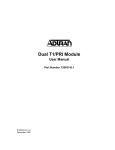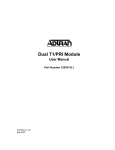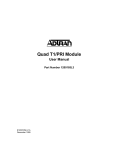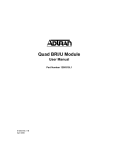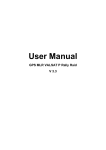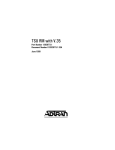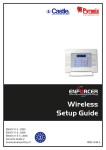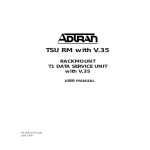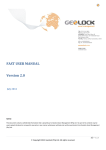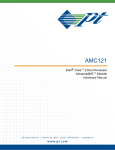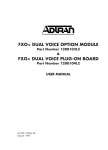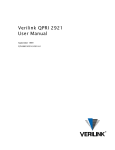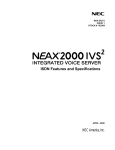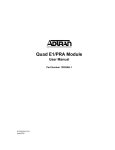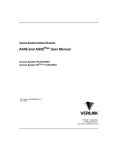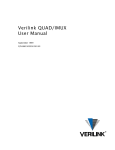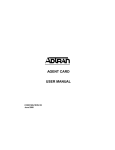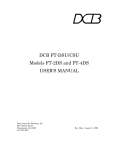Download Quad T1/PRI Module - Optimum Data Inc.
Transcript
Quad T1/PRI Module Part Number 1200185L2 USER MANUAL 61200.185L2-1A April 1998 901 Explorer Boulevard P.O. Box 140000 Huntsville, AL 35814-4000 (256) 963-8000 © 1998 ADTRAN, Inc. All Rights Reserved. Printed in U.S.A. FCC regulations require that the following information be provided to the customer in this manual: 1. This equipment complies with Part 68 of the FCC rules. The required label is affixed to the bottom of the chassis. 2. An FCC compliant telephone cord and modular plug is provided with this equipment. This equipment is designed to be connected to the telephone network or premises wiring using a compatible modular jack which is Part 68 compliant. See Installation Instructions for details. 3. If your telephone equipment (Quad T1/PRI Module) causes harm to the telephone network, the telephone company may discontinue your service temporarily. If possible, they will notify you in advance. But if advance notice isn’t practical, you will be notified as soon as possible. You will be advised of your right to file a complaint with the FCC. 4. Your telephone company may make changes in its facilities, equipment, operations, or procedures that could affect the proper operation of your equipment. If they do, you will be given advance notice so as to give you an opportunity to maintain uninterrupted service. 5. If you experience trouble with this equipment (Quad T1/PRI Module), please contact ADTRAN at (205) 963-8000 for repair/ warranty information. The telephone company may ask you to disconnect this equipment from the network until the problem has been corrected, or until you are sure the equipment is not malfunctioning. 6. This unit contains no user-serviceable parts. 7. The following information may be required when applying to your local telephone company for leased line facilities. Service Type REN/SOC FIC USOC 1.544 Mbps - SF 1.544 Mbps - SF and B8ZS 1.544 Mbps - ESF 1.544 Mbps - ESF and B8ZS ISDN 6.0F 6.0F 6.0F 6.0F 6.0N 04DU9-BN 04DU9-DN 04DU9-1KN 04DU9-1SN 04DU9-ISN RJ48C RJ48C RJ48C RJ48C RJ48C FEDERAL COMMUNICATIONS COMMISSION RADIO FREQUENCY INTERFERENCE STATEMENT: This equipment has been tested and found to comply with the limits for a Class A digital device, pursuant to Part 15 of the FCC Rules. These limits are designed to provide reasonable protection against harmful interference when the equipment is operated in a commercial environment. This equipment generates, uses, and can radiate radio frequency energy and, if not installed and used in accordance with the instruction manual, may cause harmful interference to radio frequencies. Operation of this equipment in a residential area is likely to cause harmful interference in which case the user will be required to correct the interference at his own expense. Shielded cables must be used with this unit to ensure compliance with Class A FCC limits. Change or modifications to this unit not expressly approved by the party responsible for compliance could void the user’s authority to operate the equipment. AFFIDAVIT REQUIREMENTS FOR CONNECTION TO DIGITAL SERVICES • An affidavit is required to be given to the telephone company whenever digital terminal equipment without encoded analog content and billing protection is used to transmit digital signals containing encoded analog content which are intended for eventual conversion into voiceband analog signals and transmitted on the network. • The affidavit shall affirm that either no encoded analog content or billing information is being transmitted or that the output of the device meets Part 68 encoded analog content or billing protection specifications. • End user/customer will be responsible to file an affidavit with the local exchange carrier when connecting unprotected CPE to a 1.544 Mbps or subrate digital services. • Until such time as subrate digital terminal equipment is registered for voice applications, the affidavit requirement for subrate services is waived. AFFIDAVIT FOR CONNECTION OF CUSTOMER PREMISES EQUIPMENT TO 1.544 MBPS AND/OR SUBRATE DIGITAL SERVICES For the work to be performed in the certified territory of _______________ (telco name) State of ________________ County of ________________ I, _____________________________ (name), _____________________ (business address), ____________________ (telephone number) being duly sworn, state: I have responsibility for the operation and maintenance of the terminal equipment to be connected to 1.544 Mbps and/or ________ subrate digital services. The terminal equipment to be connected complies with Part 68 of the FCC rules except for the encoded analog content and billing protection specifications. With respect to encoded analog content and billing protection: ( ) I attest that all operations associated with the establishment, maintenance, and adjustment of the digital CPE with respect to analog content and encoded billing protection information continuously complies with Part 68 of the FCC Rules and Regulations. ( ) The digital CPE does not transmit digital signals containing encoded analog content or billing information which is intended to be decoded within the telecommunications network. ( ) The encoded analog content and billing protection is factory set and is not under the control of the customer. I attest that the operator(s)/maintainer(s) of the digital CPE responsible for the establishment, maintenance, and adjustment of the encoded analog content and billing information has (have) been trained to perform these functions by successfully having completed one of the following (check appropriate blocks): ( ) A. A training course provided by the manufacturer/grantee of the equipment used to encode analog signals; or ( ) B. A training course provided by the customer or authorized representative, using training materials and instructions provided by the manufacturer/grantee of the equipment used to encode analog signals; or ( ) C. An independent training course (e.g., trade school or technical institution) recognized by the manufacturer/grantee of the equipment used to encode analog signals; or ( ) D. In lieu of the preceding training requirements, the operator(s)/maintainer(s) is (are) under the control of a supervisor trained in accordance with _________ (circle one) above. I agree to provide _________________ (telco’s name) with proper documentation to demonstrate compliance with the information as provided in the preceding paragraph, if so requested. _________________________________Signature _________________________________Title _________________________________ Date Transcribed and sworn to before me This ________ day of ________, 199___ _________________________________ Notary Public My commission expires: _________________________________ CANADIAN EQUIPMENT LIMITATIONS The Industry Canada Certification label identifies certified equipment. This certification means that the equipment meets certain telecommunications network protective, operational, and safety requirements. The Department does not guarantee the equipment will operate to the user's satisfaction. Before installing this equipment, users should ensure that it is permissible to be connected to the facilities of the local telecommunications company. The equipment must also be installed using an acceptable method of connection. In some cases, the company's inside wiring associated with a single line individual service may be extended by means of a certified connector assembly (telephone extension cord). The customer should be aware that compliance with the above conditions may not prevent degradation of service in some situations. Repairs to certified equipment should be made by an authorized Canadian maintenance facility designated by the supplier. Any repairs or alterations made by the user to this equipment, or equipment malfunctions, may give the telecommunications company cause to request the user to disconnect the equipment. Users should ensure for their own protection that the electrical ground connections of the power utility, telephone lines and internal metallic waterpipe system, if present, are connected together. This precaution may be particularly important in rural areas. Users should not attempt to make such connections themselves, but should contact the appropriate electric inspection authority, or an electrician, as appropriate. The Load Number (LN) assigned to each terminal device denotes the percentage of the total load to be connected to a telephone loop which is used by the device, to prevent overloading. The termination on a loop may consist of any combination of devices subject only to the equipment that the total of the LNs of all devices does not exceed 100. The ringer equivalence number (REN) assigned to each terminal adapter is used to determine the total number of devices that may be connected to each circuit. The sum of the RENs from all devices in the circuit should not exceed a total of 5.0. Table of Contents Chapter 1 Introduction .............................................................................................................................................1 Quad T1/PRI Module Overview ..............................................................................................................................1 Functional Description ...............................................................................................................................................2 Features ..................................................................................................................................................................2 Quad T1/PRI Module Specifications .................................................................................................................3 Physical Description ...................................................................................................................................................4 Chapter 2 Installation ...............................................................................................................................................5 Unpack and Inspect ....................................................................................................................................................5 Contents of ADTRAN Shipment ........................................................................................................................5 Installing the Quad T1/PRI Module ........................................................................................................................5 Wiring ...........................................................................................................................................................................6 Warranty and Customer Service ...............................................................................................................................6 Chapter 3 Operation .................................................................................................................................................9 Overview ......................................................................................................................................................................9 Terminal Menu Structure ...........................................................................................................................................9 Menu Description ...............................................................................................................................................10 Quad T1/PRI Module Menu Options..............................................................................................................12 Quad T1/PRI Info........................................................................................................................................12 Alarm Status .................................................................................................................................................12 DS0 Status .....................................................................................................................................................13 Sig Status .......................................................................................................................................................13 Performance Current...................................................................................................................................13 Performance 15Min......................................................................................................................................14 Performance 24hr.........................................................................................................................................14 Configuration ...............................................................................................................................................14 Test .................................................................................................................................................................16 ATLAS Features used with Quad T1/PRI Module ..............................................................................................17 Factory Restore ....................................................................................................................................................17 Run Self Test ........................................................................................................................................................17 Mapping ...............................................................................................................................................................17 Appendix A Quad T1/PRI Dial Plan Interface Configuration ....................................................................... 19 Interface Configuration ............................................................................................................................................19 Quad T1/PRI Module Interface Configuration..............................................................................................19 Quad T1/PRI Module (Network Termination/PRI)..............................................................................20 Quad T1/PRI Module (Network Termination/RBS) .............................................................................22 Quad T1/PRI Module (User Termination/PRI) .....................................................................................24 Quad T1/PRI Module (User Termination/RBS).....................................................................................25 61200.185L1-1 Quad T1/PRI Module User Manual vii Table of Contents viii Quad T1/PRI Module User Manual 61200.185L1-1 List of Figures Figure 1-1. T1 Bandwidth Management Application ........................................................................................... 2 Figure 1-2. Quad T1/PRI Module ........................................................................................................................... 4 Figure 2-1. Installing the Quad T1/PRI Module ................................................................................................... 6 Figure 3-1. Modules Menu...................................................................................................................................... 10 Figure 3-2. Quad T1/PRI Menu Options.............................................................................................................. 12 Figure 3-3. Network Loopback Test ...................................................................................................................... 16 Figure A-1. Dial Plan Menus .................................................................................................................................. 19 61200.185L2-1 Quad T1/PRI Module User Manual ix List of Figures x Quad T1/PRI Module User Manual 61200.185L2-1 Introduction Chapter 1 QUAD T1/PRI MODULE OVERVIEW The Quad T1/PRI Module is a member of the ATLAS family of Integrated Access products and provides four channelized T1 or Primary Rate ISDN (PRI) interfaces. Each interface can operate independently in DS-1 or DSX-1 mode, and any port can serve as the primary or backup timing source for the entire system. The Quad T1/PRI Module combines with the ATLAS base unit and other ATLAS modules to support requirements calling for multiple T1 and/or PRI circuits. As many Quad T1/PRI Modules can be installed in a system as can be physically accommodated in the ATLAS chassis. Typical applications calling for ATLAS and the Quad T1/PRI Module include the following: • Digital Access Cross Connect System (DACS). Any DS0 on any T1 circuit can be switched to any other DS0 on any other T1 circuit. • T1 Bandwidth Management. T1 circuits carrying voice, data, video, and other traffic can have their payload groomed and directed to the appropriate interface inside the ATLAS system. • ISDN Access Switch. When combined with the Octal BRI/U Module, the Quad T1/PRI Module can combine multiple Basic Rate ISDN circuits onto one or more Primary Rate ISDN circuits. Figure 1-1 shows the T1 bandwidth management application. 61200.185L2-1 Quad T1/PRI Module User Manual 1 Chapter 1: Introduction Figure 1-1. T1 Bandwidth Management Application FUNCTIONAL DESCRIPTION The Quad T1/PRI Module can be installed in any available option slot in the ATLAS chassis. The status of the module itself, as well as the circuits to which it interfaces, can be viewed from the ATLAS front panel. Additional status information is available via the terminal menu, accessible through either a VT 100 terminal connected to the ATLAS base unit’s control port or through a Telnet session established through the base unit’s Ethernet port. The Quad T1/PRI Module can be configured and application software can be downloaded using the terminal menu. Features • Four T1 interfaces • Each interface configurable for DS-1, DSX-1, or PRI • AT&T 62411 and ANSI T1.403 compliant • Diagnostic loopback support • Various timing options • T1 ESF diagnostics • Bantum monitor jacks on each interface • Performance per ANSI T1.403 and AT&T 54016, and ANSI T1.102 • RJ-48C network interface connector • AMI or B8ZS coding • ESF or SF(D4) framing • Line build-out settings: DSX-1: 0 to 655 feet in 133-foot increments 2 Quad T1/PRI Module User Manual 61200.185L2-1 Chapter 1: Introduction DS-1: -22.5, -15, -7.5, and 0 dB • Monitor jack • Line loopback (VT 100/remote/in-band) • Payload loopback • PRI switch support for the following switches: ATT 5ESS NT or LT Nortel DMS-100 NT or LT NI-2 NT (network termination) • Supports inherent DACS capability of the ATLAS • Report line performance data via SNMP in RFC1406 format • Trunk conditioning Quad T1/PRI Module Specifications Each port of the Quad T1/PRI Module conforms to the following specifications: Line rate 1.544 Mbps, + 75 bps Capacity T1: 1 to 24 DS0s PRI: 23B +D 61200.185L2-1 Line Codes AMI (alternate mark inversion) or B8ZS (bipolar return to zero) Framing D4 or ESF Tests Power-up self test, line loopback, port loopback Connectors RJ-48C (eight position modular jack) Terminating Impedance 100 ohms + 5% Quad T1/PRI Module User Manual 3 Chapter 1: Introduction PHYSICAL DESCRIPTION The Quad T1/PRI Module plugs into any available option slot in the rear of the ATLAS 800 or ATLAS 800 PLUS. (See Figure 1-2.) T1/ISDN PRI Figure 1-2. Quad T1/PRI Module The Quad T1/PRI Module has an indication over each RJ-48C connector referring to the port on the card. Each port has an RJ-48C connector for the T1 circuit interface and a single bantam plug for monitoring received data. 4 Quad T1/PRI Module User Manual 61200.185L2-1 Installation Chapter 2 UNPACK AND INSPECT Carefully inspect the Quad T1/PRI Module for any shipping damages. If damage is suspected, file a claim immediately with the carrier and then contact ADTRAN Technical Support (see the last page of this manual for pertinent information). If possible, keep the original shipping container for shipping the Quad T1/PRI Module back for repair or for verification of damage during shipment. Contents of ADTRAN Shipment The following items are included in the ADTRAN shipment: • Quad T1/PRI Module • Quad T1/PRI Module User Manual (to be inserted into the ATLAS User Manual) • Four cables (RJ-48C to RJ-48C) • Two crossover cables (RJ-48C to RJ-48C) • Two RJ-48 to DB-15 adapters INSTALLING THE QUAD T1/PRI MODULE Figure 2-1represents the action required for proper placement of the Quad T1/PRI Module, as described here: 1. Remove the cover plate from the ATLAS 800 or 800 PLUS rear panel. 2. Slide the Quad T1/PRI Module into the option slot until the module is firmly positioned against the front of the chassis. 3. Fasten the thumbscrews at both edges of the module. 61200.185L2-1 Quad T1/PRI Module User Manual 5 Chapter 2: Installation Figure 2-1. Installing the Quad T1/PRI Module WIRING Each port of the Quad T1/PRI Module offers a single eight-position modular jack for connecting to the T1 or PRI circuit. Table 2-1 gives the pinout for this jack. Table 2-1. Network Connection Pinout PIN NAME DESCRIPTION 1 R1 RXDATA Receive data from the network ring 2 T1 RXDATA Receive data from the network tip 3 UNUSED — 4 R TXDATA Send data towards the network ring 5 T TXDATA Send data towards the network tip 6,7,8 UNUSED — The required wiring connection is described here: Connector Type (USOC) RJ-48C WARRANTY AND CUSTOMER SERVICE ADTRAN will replace or repair this product within five years from the date of shipment if the product does not meet its published specification, or if it fails while in service. For detailed warranty, repair, and return information, refer to the ADTRAN Equipment Warranty and Repair and Return Policy Procedure (see the last page of this manual for pertinent information). 6 Quad T1/PRI Module User Manual 61200.185L2-1 Chapter 2: Installation A return material authorization (RMA) is required prior to returning equipment to ADTRAN. For service, RMA requests, or more information, see the last page of this manual for the toll-free contact number. 61200.185L2-1 Quad T1/PRI Module User Manual 7 Chapter 2: Installation 8 Quad T1/PRI Module User Manual 61200.185L2-1 Operation Chapter 3 OVERVIEW The Quad T1/PRI Module can be configured and controlled from a variety of sources, including the following: • The ATLAS front panel, providing minimal configuration and status support • The terminal menu, allowing detailed configuration, status, and diagnostics • SNMP, used primarily for reporting alarm conditions and system status The terminal menu is accessed using either a VT 100 terminal attached to the ATLAS base unit’s control port or a Telnet session established through the base unit’s Ethernet port. Detailed instructions on the operation of each of the supported management approaches are presented in the ATLAS User Manual. To edit items in the terminal menu, you must have the appropriate password level. Each menu description in this section indicates the password level required for write and read access. See “Access Passwords” in the ATLAS User Manual for detailed information on working with passwords. Security level 0 users can view and edit every available field. Security level 5 users can view any field but cannot edit. The remainder of this section describes the available menu items when managing the Quad T1/PRI Module via the terminal menu. TERMINAL MENU STRUCTURE ATLAS uses a form of hierarchical menus to access all features. The topmost menu level leads to submenus which are grouped by functionality. All menu items display in the terminal window. 61200.185L2-1 Quad T1/PRI Module User Manual 9 Chapter 3: Operation Refer to the ATLAS User Manual for detailed instructions on how to navigate through the terminal menu. The ATLAS system controller automatically detects the presence of the Quad T1/PRI Module when it is installed in the system. To see the menus for the Quad T1/PRI Module via the terminal menu, use the arrow keys to scroll to the Modules menu and press ENTER to access the module choices. Figure 3-1 shows the Modules menu. The following sections describe all the ATLAS Modules menu options. Figure 3-1. Modules Menu Menu Description Slt Read security: 5 Displays the number of available option slots in the ATLAS chassis. Slot 0 refers to the ATLAS base unit. This field is read-only. Type Write security: 3; Read security: 5 Displays the type of module actually installed in the slot or the type of module you plan to install in the slot. If a Quad T1/PRI Module is installed, the Type field automatically defaults to T1/PRI-4 (the Quad T1/PRI Module). You can use this field to preconfigure a system before installing modules by specifying the module that you want to install into each slot. If you install one type of module in a slot, and then want to install a different type of module in the slot, you must set this field to Empty before selecting the other module type. If a module is installed, the module type automatically displays the name of the 10 Quad T1/PRI Module User Manual 61200.185L2-1 Chapter 3: Operation installed module, and cannot be set to any other option. Menu Displays additional status and configuration menus for the selected module. (To access the submenus for this item, use the arrow keys to scroll to the Menu column for the module you want to edit, and press ENTER.) For detailed information on each submenu item, see Quad T1/PRI Module Menu Options on page 12. Alarm Read security: 5 Displays whether there is an alarm condition on the Quad T1/PRI Module. Press Enter in this field to activate the Alarm menu. Test Read security: 5 Displays whether the Quad T1/PRI Module is executing a test. Press Enter in this field to activate the Test menu. State Write security: 3; Read security: 5 Displays whether the module is online or offline. Even though a module is physically installed, it must be marked Online for it to be considered an available resource. This field allows an installed module to be marked Offline, which may be useful in system troubleshooting. If you choose Offline, the module will not be in alarm condition, but will display Offline. A module must be in the Online state in order for ATLAS to use the module for any data bandwidth. Status Read security: 5 Read-only field that presents status information on the Quad T1/PRI Module. The following messages may display: 61200.185L2-1 Online The module is enabled and is responding to the system controller’s status polls. This is the normal response of the system. No Response The module is enabled, but is not responding to the system controller’s status polls. This response indicates either a problem in the system or that the module is not installed. Empty The system controller has not detected the presence of a module in the slot, nor has a module been manually enabled for this option slot. Offline The module is installed, but has been taken Offline by a user. The module is still responding to controller polls. Offline/ No Response The module is installed, but has been taken Offline by a user. The module is not responding to controller polls. Quad T1/PRI Module User Manual 11 Chapter 3: Operation Rev (Hardware Revision) Read security: 5 Read-only field that displays the hardware revision of the Quad T1/PRI Module. Quad T1/PRI Module Menu Options Figure 3-2 shows the menu options available for the Quad T1/PRI Module. The following sections describe these options. Figure 3-2. Quad T1/PRI Menu Options Quad T1/PRI Info Read security: 5 Indicates the status of the module. Part Num Displays the part number of the module (read only). PLL Status Indicates whether the clock is locked to its specific source. Board Rev Displays the PCB revision (read only). Alarm Status Read security: 5 In the Alarm Status submenu the following indications are available: Prt Indicates the port number. Loss of Signal (LOS) Indicates no signal detected on port interface. 12 Quad T1/PRI Module User Manual 61200.185L2-1 Chapter 3: Operation Red Alarm (RED) Indicates inability to frame data received on the port. Alternately referred to as Out of Frame (OOF). Yellow Alarm (YELLOW) Indicates remote alarm (RAI) being received on port. Blue Alarm (BLUE) Indicates receiving unframed all 1s from the port alarm indicator signal (AIS). D Channel Sync (D-Chan) Indicates HDLC framing is operational on PRI D channel. This indication only applies when operating in PRI mode. Receive Level (Rx Level) Indicates the strength of the signal (in dB) received on the port. DS0 Status Read security: 5 The DS0 status indicates usage on a DS0 basis for each port. These options are read-only: * Inactive A Active call on this DS0 D Active D Channel DS0 M Maintenance DS0 N Dedicated DS0 O Off hook Detected R Ringing Detected Sig Status Read security: 5 Read-only field indicates signaling of all 24 DS0s. The A/B bits for Rx (receive) and Tx (transmit) DS0s are shown for each port. Dashes display for those DS0s where robbed bit signaling is not being transferred by ATLAS. Performance Current Write security: 4; Read security: 5 The performance fields (either current, 15-minute total, or 24-hour total) provide status on key performance measures as specified in ANSI T1.403 and AT&T TR54016 for each of the four T1/PRI ports. Excepting CLR, these fields are all read-only. The parameters monitored are as follows: Prt Displays the port number. 61200.185L2-1 Quad T1/PRI Module User Manual 13 Chapter 3: Operation CLR Clears performance information for the selected port. ES Errored Seconds. An ES is a second with one or more error events OR one or more Out Of Frame events OR one or more Controlled Slips. BES Bursty Errored Seconds. A BES is a second with more than one, but less than 320 error events. SES Severely Errored Seconds. An SES is a second with 320 or more error events OR one or more Out Of Frame events. SEFS Severely Errored Frame Seconds. LOFC Loss of Frame Count. CSS Controlled Slip Seconds. UAS Unavailable Seconds. LCV Line Code Violations. PCV Path Code Violations. LES Line Errored Seconds. Performance 15Min Write security: 4; Read security: 5 The Performance 15Min menu stores the performance data for the previous 15-minute window. Refer to Performance Current on page 13 for a detailed description. Performance 24hr Write security: 4; Read security: 5 The Performance 24Hr menu stores the performance data for the previous 24-hour window. Refer to Performance Current on page 13 for a detailed description. Configuration All of the following configurable parameters apply to whether the port is connected to a Primary Rate ISDN circuit or a channelized T1 circuit. 14 Quad T1/PRI Module User Manual 61200.185L2-1 Chapter 3: Operation Prt Read security: 5 Displays the port number. Port Name Write security: 3; Read security: 5 Enter any alpha-numeric name up to 16 characters long to uniquely identify each port on the Quad T1/PRI module. Frame Write security: 2; Read security: 5 This field must be set to match the frame format of the circuit to which it is connected, available from the network supplier. Choose either D4 or ESF. Code Write security: 2; Read security: 5 This field must be set to match the line code of the circuit to which it is connected (this information is available from the network supplier). Choose either AMI or B8ZS. Tx Yellow (Auto Tx Yellow Alarm) Write security: 3; Read security: 5 Controls the transmitting of yellow alarms. Choose either On or Off. Tx PRMs (Transmit PRMs) Write security: 3; Read security: 5 Controls the sending of performance report messaging (PRM) data on the facility data link (FDL). The PRM data continues to be collected even if XMIT PRM is turned off (possible only with ESF format). Choose either On or Off. Pulse Density Enforcer Write security: 3; Read security: 5 Choose either On or Off. When On, Pulse Density Enforcer causes the ATLAS to monitor for ones (1s) density violations and insert a one (1) when needed to maintain ones at 12.5% This data insertion will cause data errors. LBO (Line Build Out) Write security: 2; Read security: 5 Selects the line build out for the network interface. When connecting a Quad T1/PRI Module port to a DSX-1 interface, this parameter is typically set to match the distance (in feet) between ATLAS and the device with which it is connecting. When you select this item, a list of choices displays. Select the appropriate option. LB Accept (Loopback Accept) Write security: 3; Read security: 5 Sets unit to accept or reject the in-band loop up and loop down codes as defined in ANSI T1.403. This is a line loopback. Choose either Accept or Ignore. 61200.185L2-1 Quad T1/PRI Module User Manual 15 Chapter 3: Operation Test Write security: 4; Read security: 5 These options initiate different types of tests and display test results. These test commands temporarily disrupt service. The test menu contains the following menu options: Prt Read security: 5 Displays the port number. Loc LB (Local Loopback) Write security: 4; Read security: 5 Causes loopback on near-end port. The following options are available: • Line — Metallic loopback • Payld — Payload loopback - framing and clocking are regenerated (See Figure 3-3.) Quad T1/PRI NI CSU DS1 Payload Loopback Line Loopback Figure 3-3. Network Loopback Test Remote LB (Remote Loopback) Write security: 4; Read security: 5 Sends loopback code to remote CSU. The following options are available: • ANSI FDL Line (Requires ESF mode) • ANSI FDL Pyld (Requires ESF mode) • AT&T Inband line Pattern Write security: 4; Read security: 5 Test pattern to be transmitted out the port. The following options are available: • All ones — framed ones • All zeros — framed zeros • QRSS — pseudorandom pattern with suppression of excess zeros. 16 Quad T1/PRI Module User Manual 61200.185L2-1 Chapter 3: Operation QRSS/RLB Results (Test Pattern Results) Write security: 4; Read security: 5 Indicates sync and errors of received data pattern. Clr (Test Pattern Results Clear) Write security: 4; Read security: 5 Results clear - clears error counters on test pattern results menu. Inj (Test Pattern Error Inject) Write security: 4; Read security: 5 Injects errors into transmitted test pattern. ATLAS FEATURES USED WITH QUAD T1/PRI MODULE In addition to the Quad T1/PRI Module menu items, two additional ATLAS menu items may be operated in conjunction with the Quad T1/ PRI Module. These are Factory Restore and Run Self Test. Factory Restore Factory Restore, a submenu of the ATLAS front panel main menu item Utilities (UTIL), restores the factory installed default setting for all Quad T1/PRI module parameters. When Factory Restore displays, place the cursor on it and press Enter. The unit is restored to preset factory defaults and returns to the main ATLAS menu. Run Self Test Run Self Test, a submenu of the ATLAS main menu item Test, executes both the Quad T1/PRI Module internal test and the ATLAS internal test. For additional information on Self Test see the ATLAS User Manual. When Run Self Test is displayed, place the cursor on it and press Enter to execute the test. The results of the self test are displayed in the LCD. Mapping DS0s are used as defined in the Dedicated Map or in the Dial Plan for switched applications. (See the ATLAS User Manual for a description.) Defining a port as a T1 or PRI is determined by the way it is assigned in the Dedicated Map or in the Dial Plan. 61200.185L2-1 Quad T1/PRI Module User Manual 17 Chapter 3: Operation 18 Quad T1/PRI Module User Manual 61200.185L2-1 Appendix A Quad T1/PRI Dial Plan Interface Configuration INTERFACE CONFIGURATION The interface configuration option for the Dial Plan menu sets configuration parameters for the end point. These parameters will vary by the type of port selected. The following section describes the configuration options available for the Quad T1/PRI Module. The Dial Plan menus are only accessible when using terminal mode. To access these options, select Dial Plan from the top level menu. (See Figure A-1.) The Write security level for all Dial Plan options is 3. Figure A-1. Dial Plan Menus Quad T1/PRI Module Interface Configuration This section describes the network termination and user termination configuration settings for the Quad T1/PRI Module when using the Dial Plan menus. 61200.185L2-1 Quad T1/PRI Module User Manual 19 Appendix A: Quad T1/PRI Dial Plan Interface Configuration Quad T1/PRI Module (Network Termination/PRI) When you are working in the network termination section of the Dial Plan menu, when the Slot is defined as a Quad T1/PRI module, and when Sig is set to PRI, the following configuration options are available: Switch Type Write security: 2; Read security: 5 Defines the type of PRI switch to which the port is connected. If connected to another ATLAS, both need to be set to the same type. The following options are available: • Lucent 5E • Northern DMS 100 • National ISDN • AT&T 4ESS First DS0 Write security: 2; Read security: 5 Defines to ATLAS the DS0s which will be used for this end point. These are the DS0s which ATLAS uses to send and receive calls to and from the network (PSTN). The outgoing calls which are allowed or restricted over these DS0s are set by the Outgoing Call Accept and Reject Numbers discussed earlier. Number of DS0s Write security: 3; Read security: 5 Specifies the number of DS0s already defined for this end point. This field is read-only. Outgoing Number Conversion Write security: ; Read security: This option converts outgoing (towards the network) numbers to the numbering plan & type option selected. As dialed (default) No number conversion is made. The outgoing numbering plan and type is forwarded to the network as received and digits are passed “As dialed.” ISDN-National preferred Regardless of what type of number is received, the outgoing number is substituted with ISDN - National as the number plan and type. Ten (10) digits are always sent to the network. Leading 1’s, if present are stripped out and the Area Code (provisioned under Dial Plan Global Parameters) is prepended if only 7 digits are supplied. This may be required in areas with ten (10) digit local dialing. ISDN-Subscriber preferred The incoming number is examined and if seven digits are received or if a ten (10) digit number is received with an area code that matches the area code provisioned in the global parameters, the number is for- 20 Quad T1/PRI Module User Manual 61200.185L2-1 Appendix A: Quad T1/PRI Dial Plan Interface Configuration warded to the network as a seven (7) digit number defined as ISDN Subscriber number plan and type. If the incoming number is ten (10) digits but with a different area code, it is forwarded to the network as ISDN - National preferred. ISDN-National DMS Reserved preferred The incoming numbering plan and type are ignored and substituted with ISDN/Telephony numbering plan and National number type. Ten digits (10) are sent to the network. Leading 1’s, if present are stripped out and the Area Code set in global parameters is prepended if only 7 digits are supplied. This may be required in areas with Ten (10) digit local dialing. Network Specific Facility Write: ; Read: The purpose of this option is to enable the sending of appropriate information to the PSTN. The default for this option is Normal and in this case no Network Specific Facility Information Element is sent. Unless one of the services listed below is subscribed to, the selection should remain set to “Normal.” The list below indicates services that may be subscribed to from the PSTN. These services require that specific information (such as a Network Specific Facility Information Element) be sent to the network during call setup. • AT&T SDN • AT&T Megacom 800 - AT&T Megacom - AT&T Accunet • AT&T Long Distance • AT&T International-800 • AT&T Dial-It 900/Multiquest • National ISDN INWATS • Nortel Private Network • Nortel InWats • Nortel OutWats • Nortel Foreign Exchange • Nortel Tie Trunk Called Digits Transferred Write security: 2; Read security: 5 Some PRI switches may be provisioned to send only a portion of the called number (like DID). This menu item allows ATLAS to know how many digits to expect (choose from None, Three, Four, and All). The default is All and would almost always be correct. If less than All digits are sent, then the prefix is defined as shown below. 61200.185L2-1 Quad T1/PRI Module User Manual 21 Appendix A: Quad T1/PRI Dial Plan Interface Configuration Prefix Write security: 2; Read security: 5 This menu item only displays if Called Digits Transferred is not set to All. Enter the prefix for the digits received. Example: If the number of digits is four, and the number called is 963-8005, the Telco’s PRI switch would send only 8005, and the prefix would be set to 963. This entire number would then be used to determine which ATLAS User port end point should receive the call. Outgoing Caller ID Quad T1/PRI Module (Network Termination/RBS) When you are working in the network termination section of the Dial Plan menu, when the Slot is defined as a Quad T1/PRI Module, and when Sig is set to RBS, the following interface configuration options are available: First DS0 Write security: 2; Read security: 5 Defines to ATLAS the DS0s which will be used for this end point. These are the DS0s which ATLAS uses to send and receive calls to and from the network (PSTN). The outgoing calls which are allowed or restricted over these DS0s are set by the Outgoing Call Accept and Reject Numbers discussed earlier. Number of DS0s Write security: 3; Read security: 5 Specifies the number of DS0s already defined for this end point. This field is read-only. DS0s Available Read security: 5 Indicates which DS0s of the T1 have been defined in this switched end point (indicated by “! “), in another switched end point (indicated by “s”), or in a Dedicated Map (indicated by “n”). This field is read-only. 22 Quad T1/PRI Module User Manual 61200.185L2-1 Appendix A: Quad T1/PRI Dial Plan Interface Configuration The following symbols may display in this field: digits 0-9 This DS0 is available. The digit that displays in this field represents the last digit of the DS0 number. * This port is requesting this DS0 for this connection, but the DS0 is not yet activated. ! This DS0 is used by this end point. s This DS0 is used elsewhere in the switched dial plan. S This DS0 is in the switched dial plan and conflicts with this end point. n This DS0 is used in one or more dedicated maps. N This DS0 is in one or more dedicated maps, and conflicts with this end point. Signaling Method Write security: 3; Read security: 5 Defines to ATLAS the type of signaling to be used across this trunk. The signaling selected needs to match the signaling being provided by the network (PSTN). The following choices are available: • E&M Immediate • E&M Wink • Loop Start • Ground Start Direct Inward Dialing (DID) Write security: 3; Read security: 5 Defines to ATLAS whether DID is being used by the network. If DID is Enabled, then the following information must be defined: DID Digits Transferred Write security: 3; Read security: 5 Defines the number of digits sent to ATLAS from the network if DID is used. DID Prefix Write security: 3; Read security: 5 Defines to ATLAS the prefix digits which are not received as a part of the DID number. ATLAS uses the combination of prefix and DID number to determine the user end point that should receive the incoming call. This option only displays if direct inward dialing is set to Enabled. If DID is Disabled, then you must define the trunk number. Trunk Number Write security: 3; Read security: 5 When the network connection does not provide DID digits, ATLAS must be given a number to use to determine which user end point should 61200.185L2-1 Quad T1/PRI Module User Manual 23 Appendix A: Quad T1/PRI Dial Plan Interface Configuration receive the incoming call. Displays only when direct inward dialing is set to Disabled. The trunk number must be specific (i.e., no “wild cards”). For example, if an incoming DS0 (trunk) is meant to connect to an end point with the Accept number of 963-8615, the trunk number would be set to 963-8615. Quad T1/PRI Module (User Termination/PRI) When you are working in the user termination section of the Dial Plan menu, when the Slot is defined as a T1/PRI module, and when Sig is set to PRI, the following configuration options are available: Switch Type Write security: 3; Read security: 5 Defines the type of PRI switch that ATLAS is going to emulate. If connected to another ATLAS, both need to be set to the same type. • Lucent 5E • AT&T 4ESS First DS0 Write security: 2; Read security: 5 Defines to ATLAS the DS0s which will be used for this end point. These are the DS0s which ATLAS uses to send and receive calls to and from the network (PSTN). The outgoing calls which are allowed or restricted over these DS0s are set by the Outgoing Call Accept and Reject Numbers discussed earlier. Number of DS0s Write security: 3; Read security: 5 Specifies the number of DS0s already defined for this end point. This field is read only. Network Specific Facility Write: ; Read: The purpose of this option is to enable the sending of appropriate information to the PSTN. The default for this option is Normal and in this case no Network Specific Facility Information Element is sent. Unless one of the services listed below is subscribed to, the selection should remain set to “Normal.” The list below indicates services that may be subscribed to from the PSTN. These services require that specific information (such as a Network Specific Facility Information Element) be sent to the network during call setup. 24 Quad T1/PRI Module User Manual 61200.185L2-1 Appendix A: Quad T1/PRI Dial Plan Interface Configuration • AT&T SDN • AT&T Megacom 800 - AT&T Megacom - AT&T Accunet • AT&T Long Distance • AT&T International-800 • AT&T Dial-It 900/Multiquest • National ISDN INWATS • Nortel Private Network • Nortel InWats • Nortel OutWats • Nortel Foreign Exchange • Nortel Tie Trunk Called Digts Transferred Write security: 3; Read security: 5 Defines to ATLAS the number of digits of the called number to forward. When attached to a PBX, the PBX may be provisioned to expect to receive fewer than all of the called digits of the incoming call; however, this option would normally be set to All. Outgoing Caller ID Quad T1/PRI Module (User Termination/RBS) When you are working in the user termination section of the Dial Plan menu, when the Slot is defined as a T1/PRI module, and when Sig is set to RBS, the following configuration options are available: First DS0/Number of DS0s Write security: 3; Read security: 5 Defines to ATLAS the DS0s which will be used for this end point. ATLAS uses these DS0s to send and receive calls to and from user equipment (PBX). The incoming calls which will be accepted and the outgoing calls which will be restricted over these DS0s are set by the Incoming Call Accept and Outgoing Call Reject Numbers discussed earlier. DS0s Available Read security: 5 Indicates which DS0s of the T1 have been defined in this switched end point (indicated by “! “), in another switched end point (indicated by “s”), or in a dedicated map (indicated by “n”). 61200.185L2-1 digits 0-9 This DS0 is available. The digit that displays in this field represents the last digit of the DS0 number. * This port is requesting this DS0 for this connection, but the DS0 is not yet activated. Quad T1/PRI Module User Manual 25 Appendix A: Quad T1/PRI Dial Plan Interface Configuration ! This DS0 is used by this end point. s This DS0 is used elsewhere in the switched dial plan. S This DS0 is in the switched dial plan and conflicts with this end point. n This DS0 is used in one or more dedicated maps. N This DS0 is in one or more dedicated maps and conflicts with this end point. Signaling Method Write security: 3; Read security: 5 Defines to ATLAS the type of signaling to be used across this trunk. The selected signaling must match that being used by the user equipment (PBX). The choices are as follow: • E&M Immediate • E&M Wink • Loop Start • Ground Start ATLAS converts signaling types between network and user terminations. Direct Inward Dialing (DID) Defines to ATLAS whether DID is used by the user equipment. If DID is Enabled, then the following information must be defined: DID Digits Transferred Defines the number of digits ATLAS sends on to the user equipment. This field only displays if direct inward dialing is set to Enabled. Caller ID Number Defines the number ATLAS uses to provide caller ID to the network for outgoing calls sent through this end point. This option only displays if direct inward dialing is set to Disabled. This item is optional. The Caller ID number must be specific (i.e., no “wild cards”). 26 Quad T1/PRI Module User Manual 61200.185L2-1 Index Symbols ! 23 * 23 D D channel sync 13 description functional 2 physical 4 DID 23, 26 digits transferred 23, 26 prefix 23 direct inward dialing 23, 26 DS0 available 22, 25 first 20, 22, 24, 25 number of 20, 22, 24, 25 DSO status 13 A alarm blue 13 red 12, 13 yellow 13 yellow auto TX 15 alarm status 12 alarms 6, 11 applications typical 1 arrow keys 10 AT&T 4ESS 20 ATLAS 800 1 ATLAS features 17 auto TX yellow alarm 15 available DS0s 22, 25 E E&M immediate 23, 26 wink 23, 26 B bandwidth management application 1, 2 blue alarm 13 C called digits transferred 21, 25 caller ID number 26 capacity 3 clock source tests 3 code 15 configuration 14 Quad T1/PRI interface 19 connectors 3 customer service 6 61200.185L2-1 F factory restore 17 features 2 ATLAS 17 first DS0 20, 22, 24 frame 15 framing options 3 functional description 2 G ground start 26 H hardware revision 12 Quad T1/PRI Module User Manual 27 Index I installing 5 option module 5, 6 interface configuration Quad T1/PRI 19 introduction 1 Quad T1/PRI configuration 20 Northern DMS 100 20 Quad T1/PRI 24 number of DS0s 25 number of DS0s 20, 22, 24 O operation 9 operation alarms 6 overview 1 operation 9 L line build out 15 line codes 3 line rate 3 local loopback 16 loop start 26 loopback local 16 remote 16 loopback accept 15 LOS 12 loss of signal 12 Lucent 5E 20 Quad T1/PRI 24 P performance 15 min 14 24 hours 14 performance current 13 physical description 4 pinouts 6 port name 15 prefix 22 PRI Quad T1/PRI 24 Quad T1/PRI configuration 20 PRI switch 20 product support information 31 pulse density enforcer 15 M mapping 17 menu description 10 modules 10 traversal 10 menu options quad T1/PRI 12 method signaling 23 modules menu 10 N N 23 n 23 National ISDN 20 network termination configuration settings 19 network pinouts 6 network termination Quad T1/PRI 22 28 Q Quad PRI info 12 Quad T1/PRI interface configuration 19 network termination/PRI 20 network termination/RBS 22 user termination/PRI 24 user termination/RBS 25 Quad T1/PRI overview 1 R RBS Quad T1/PRI 22, 25 receive level 13 red alarm 13 remote loopback 16 Quad T1/PRI Module User Manual 61200.185L2-1 Index repair 31 repair and return 31 restore 17 return 31 RMA 31 RMA requests 7 run self test 17 Quad T1/PRI 24, 25 W warranty 6 wiring 6 Y yellow alarm 12, 13 auto TX 15 S S 23 s 23 self test 17 service 6, 7 shipped by ADTRAN 5 sig status 13 signaling method 23, 26 specifications 3 start ground 26 loop 26 state 11 status 11 alarm 12 DSO 13 sig 13 support 6 support information 31 switch type 20 Quad T1/PRI 24 T technical support 6 terminating impedance 3 test 11, 16 test pattern 16 error inject 17 transmit PRMs 15 trunk number 23 type 10 U user termination configuration settings 19 61200.185L2-1 Quad T1/PRI Module User Manual 29 Index 30 Quad T1/PRI Module User Manual 61200.185L2-1 Product Support Information Presales Inquiries and Applications Support Please contact your local distributor, ADTRAN Applications Engineering, or ADTRAN Sales: Applications Engineering (800) 615-1176 Sales (800) 827-0807 Post-Sale Support Please contact your local distributor first. If your local distributor cannot help, please contact ADTRAN Technical Support and have the unit serial number available. Technical Support (888) 4ADTRAN Repair and Return If ADTRAN Technical Support determines that a repair is needed, Technical Support will coordinate with the Customer and Product Service (CAPS) department to issue an RMA number. For information regarding equipment currently in house or possible fees associated with repair, contact CAPS directly at the following number: CAPS Department (256) 963-8722 Identify the RMA number clearly on the package (below address), and return to the following address: ADTRAN, Inc. CAPS Department 901 Explorer Boulevard Huntsville, Alabama 35806 RMA # _____________










































